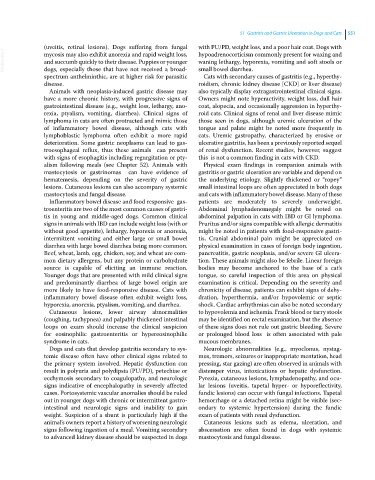Page 583 - Clinical Small Animal Internal Medicine
P. 583
51 Gastritis and Gastric Ulceration in Dogs and Cats 551
(uveitis, retinal lesions). Dogs suffering from fungal with PU/PD, weight loss, and a poor hair coat. Dogs with
VetBooks.ir mycosis may also exhibit anorexia and rapid weight loss, hypoadrenocorticism commonly present for waxing and
waning lethargy, hyporexia, vomiting and soft stools or
and succumb quickly to their disease. Puppies or younger
dogs, especially those that have not received a broad‐
Cats with secondary causes of gastritis (e.g., hyperthy-
spectrum anthelminthic, are at higher risk for parasitic small bowel diarrhea.
disease. roidism, chronic kidney disease [CKD] or liver disease)
Animals with neoplasia‐induced gastric disease may also typically display extragastrointestinal clinical signs.
have a more chronic history, with progressive signs of Owners might note hyperactivity, weight loss, dull hair
gastrointestinal disease (e.g., weight loss, lethargy, ano- coat, alopecia, and occasionally aggression in hyperthy-
rexia, ptyalism, vomiting, diarrhea). Clinical signs of roid cats. Clinical signs of renal and liver disease mimic
lymphoma in cats are often protracted and mimic those those seen in dogs, although uremic ulceration of the
of inflammatory bowel disease, although cats with tongue and palate might be noted more frequently in
lymphoblastic lymphoma often exhibit a more rapid cats. Uremic gastropathy, characterized by erosive or
deterioration. Some gastric neoplasms can lead to gas- ulcerative gastritis, has been a previously reported sequel
troesophageal reflux, thus these animals can present of renal dysfunction. Recent studies, however, suggest
with signs of esophagitis including regurgitation or pty- this is not a common finding in cats with CKD.
alism following meals (see Chapter 52). Animals with Physical exam findings in companion animals with
mastocytosis or gastrinomas can have evidence of gastritis or gastric ulceration are variable and depend on
hematemesis, depending on the severity of gastric the underlying etiology. Slightly thickened or “ropey”
lesions. Cutaneous lesions can also accompany systemic small intestinal loops are often appreciated in both dogs
mastocytosis and fungal disease. and cats with inflammatory bowel disease. Many of these
Inflammatory bowel disease and food responsive gas- patients are moderately to severely underweight.
troenteritis are two of the most common causes of gastri- Abdominal lymphadenomegaly might be noted on
tis in young and middle‐aged dogs. Common clinical abdominal palpation in cats with IBD or GI lymphoma.
signs in animals with IBD can include weight loss (with or Pruritus and/or signs compatible with allergic dermatitis
without good appetite), lethargy, hyporexia or anorexia, might be noted in patients with food‐responsive gastri-
intermittent vomiting and either large or small bowel tis. Cranial abdominal pain might be appreciated on
diarrhea with large bowel diarrhea being more common. physical examination in cases of foreign body ingestion,
Beef, wheat, lamb, egg, chicken, soy, and wheat are com- pancreatitis, gastric neoplasia, and/or severe GI ulcera-
mon dietary allergens, but any protein or carbohydrate tion. These animals might also be febrile. Linear foreign
source is capable of eliciting an immune reaction. bodies may become anchored to the base of a cat’s
Younger dogs that are presented with mild clinical signs tongue, so careful inspection of this area on physical
and predominantly diarrhea of large bowel origin are examination is critical. Depending on the severity and
more likely to have food‐responsive disease. Cats with chronicity of disease, patients can exhibit signs of dehy-
inflammatory bowel disease often exhibit weight loss, dration, hyperthermia, and/or hypovolemic or septic
hyporexia, anorexia, ptyalism, vomiting, and diarrhea. shock. Cardiac arrhythmias can also be noted secondary
Cutaneous lesions, lower airway abnormalities to hypovolemia and ischemia. Frank blood or tarry stools
( coughing, tachypnea) and palpably thickened intestinal may be identified on rectal examination, but the absence
loops on exam should increase the clinical suspicion of these signs does not rule out gastric bleeding. Severe
for eosinophilic gastroenteritis or hypereosinophilic or prolonged blood loss is often associated with pale
syndrome in cats. mucous membranes.
Dogs and cats that develop gastritis secondary to sys- Neurologic abnormalities (e.g., myoclonus, nystag-
temic disease often have other clinical signs related to mus, tremors, seizures or inappropriate mentation, head
the primary system involved. Hepatic dysfunction can pressing, star gazing) are often observed in animals with
result in polyuria and polydipsia (PU/PD), petechiae or distemper virus, intoxications or hepatic dysfunction.
ecchymosis secondary to coagulopathy, and neurologic Pyrexia, cutaneous lesions, lymphadenopathy, and ocu-
signs indicative of encephalopathy in severely affected lar lesions (uveitis, tapetal hyper‐ or hyporeflectivity,
cases. Portosystemic vascular anomalies should be ruled fundic lesions) can occur with fungal infections. Tapetal
out in younger dogs with chronic or intermittent gastro- hemorrhage or a detached retina might be visible (sec-
intestinal and neurologic signs and inability to gain ondary to systemic hypertension) during the fundic
weight. Suspicion of a shunt is particularly high if the exam of patients with renal dysfunction.
animal’s owners report a history of worsening neurologic Cutaneous lesions such as edema, ulceration, and
signs following ingestion of a meal. Vomiting secondary abscessation are often found in dogs with systemic
to advanced kidney disease should be suspected in dogs mastocytosis and fungal disease.

